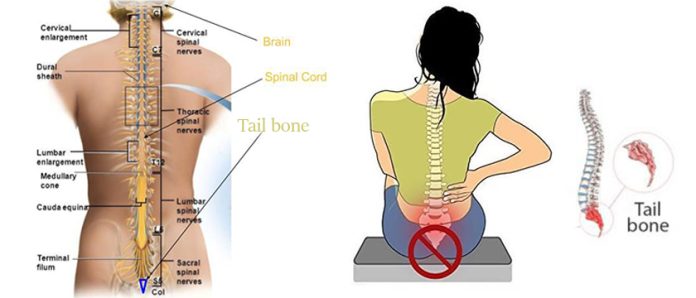Estimated reading time: 0 minutes
Coccydynia, also known as tailbone pain, is a form of pain that affects the very base of your spine. This discomfort could be the result of a direct trauma or have no discernible cause. The pain can be excruciating and last for weeks or months.
This blog will educate you everything you need to know about your tailbone (coccyx), including tailbone pain’s causes, symptoms, and treatments.
Importance of your posterior tailbone
This bone at the extremity of your spine is composed of three to five fused segments. 1 The bone has limited mobility and connects to the sacrum above. The principal functions of the tailbone are as follows:
Attach various pelvic muscles and ligaments together.
Maintain a strong pelvic floor.
Allow for voluntary control of the bowels.
By taking a step back, you can assist women in having natural births.
If the coccyx is injured, it can be a significant source of pain.
There are five potential causes of tailbone discomfort.
Pain in the coccyx can be caused by direct trauma, repetitive injury, or degeneration of the coccyx joint(s). Here are five possible causes of tailbone discomfort:
1. Coccyx contusion, fracture, or dislocation
Causes of damage to the coccyx’s structural segments or ligaments include:
Direct buttock trauma, such as sliding on ice or falling down stairs and landing in a seated position, can cause buttock fractures.
The coccyx is stretched beyond its normal range of motion during childbirth.
Being expectant or overweight may increase the likelihood of a tailbone bruise resulting from trauma.
2. Changes in the anatomy of the coccyx
A normal tailbone typically has a modest forward angle. If this position shifts because of anatomical variations, the tailbone can 3:
If positioned further back, it may irritate delicate tissues.
If placed further forward, it could impede bowel movements or labour.
Instable segments of the tailbone can also result in coccygeal dynamic instability. This condition is characterised by excessive movement of one or more body segments, especially while seated.
3. Spurs of bone on the coccyx
Near the point of your tailbone, bone spurs (thickened or enlarged bone) may alter its length and/or normal angle. When you lean backward and/or sit erect, the bone spur(s) can pinch the skin and underlying tissues, causing pain.
4. Arthritis of the coccyx
Due to wear and tear, osteoarthritis (degenerative arthritis) can develop in the coccyx joints, causing tailbone discomfort.
5. Infections and lesions affecting the coccyx
Infections or tumours can influence the coccyx and cause pain. Chondroma, a malignant bone tumour, is more prevalent in the region of the coccyx.
In patients with immunodeficiency, peritonitis, or a history of coccygeal surgery, osteomyelitis, a spinal infection, can affect the coccyx.
Hyperactivity of the pelvic floor muscles may contribute to or exacerbate tailbone pain.
Tailbone problems make sitting uncomfortable.
Symptoms of tailbone injuries are typically predictable. Depending on the cause and severity, a damaged tailbone can cause pain spanning from a dull ache to a sharp, stabbing pain.
There are three distinct indications of a broken tailbone:
- Sitting is painful. The majority of your body weight is supported by your tailbone when you are seated. If you have coccydynia, sitting may be challenging and cause pain in the region around your tailbone. Both firm and soft surfaces may be uncomfortable to sit on.
- While partially reclined, pain is present. When you lean back while seated, the pressure on the coccyx exacerbates the discomfort in your tailbone.
- It is painful to rise from a reclining position. The transition from sitting to standing may aggravate your tailbone discomfort. This increase in pain may be more prevalent in individuals with coccygeal dynamic instability, which is characterised by excessive movement of the coccygeal bones while seated and a rapid return to the normal position when upright.
While seated, tailbone pain can be alleviated by reclining forward or on one buttock to reduce the amount of weight on the tailbone.
Suggestions for relieving tailbone pain
Typically, tailbone pain resolves on its own. You can relieve your tailbone pain at home by performing the following:
Utilise coccyx cushions (doughnut, U-shaped, or wedge-shaped cushions) while seated.
Utilising heat and ice to alleviate discomfort
Utilising over-the-counter stool softeners to alleviate pressure on the coccyx during a gastrointestinal movement.
modifying activities to reduce idleness
Consult a physician for an accurate diagnosis and medical treatment if these measures fail to alleviate your tailbone pain. Your doctor may recommend steroid or nerve block injections, coccygeal manipulation, and/or pelvic floor physical therapy for tailbone pain. Coccygectomy (surgical removal of the coccyx) may be recommended in uncommon cases and based on the underlying cause.
Related-
Know more about Ayurvedic Spinal Disk & Radiculopathy Treatments.
GET IN TOUCH


Recent comments